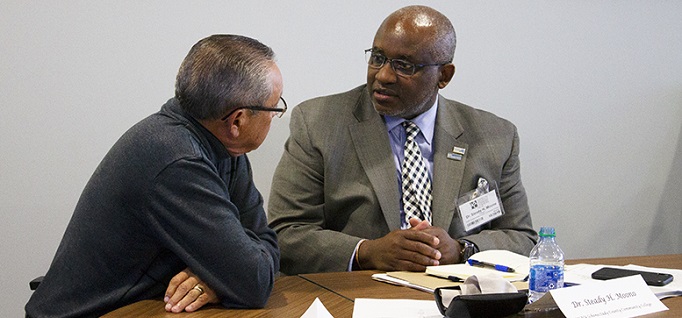Gauging campus climates
By Tabitha Whissemore
November 6, 2019
Evaluating the campus climate — particularly in terms of diversity, equity and inclusion — is a necessity but also a large undertaking.
A group of community college administrators convened this week at the American Association of Community Colleges (AACC) offices in Washington, D.C., to discuss the hows and whys of conducting campus climate diversity surveys.
Most community college administrators know their institution’s completion rates and student demographics, as well as faculty and staff demographics. So why conduct a campus climate survey?
Because it can help colleges understand if they are aligned with their mission and values, to see where gaps occur and, more importantly, to “find the ‘why’ for the gaps,” said facilitator Kimberly Baker-Flowers. She currently is university diversity officer at California State University, East Bay, and previously served as chief diversity officer at Portland Community College (Oregon).
“We have to know what our baseline is,” she said. “Once we know, we can do better.”
Deeper layers
Campus climate surveys can give people a way – often anonymously – to share their “true, lived experience,” she said.
“It may be a Pandora’s box, but it will allow you to truly serve your community,” Baker-Flowers added.
“We make assumptions that we know what’s best for students,” said Deidra Dennie, chief diversity officer at Maryland’s Anne Arundel Community College. “Once you ask them, you open up the floodgates.”
The data from surveys can help college leaders make informed decisions and can inform the strategic plan.
As employers begin to place more importance on diversity in the workplace, there’s also a business case for conducting a campus climate survey, Baker-Flowers said.
Fit to your college’s needs
There are several different ways to conduct campus climate surveys. Some are qualitative and involve focus groups that include staff, faculty and staff. Others are quantitative. Some are conducted internally, and others are outsourced.
How it’s done is often dictated by cost and capacity, Baker-Flowers said. And it’s not a one-size-fits-all approach. What works for one college may not work for another.
“It needs to be what you need it to be,” she said.
If a college does handle the process internally, there may be some distrust about the data. And if a college chooses to use a consultant or pre-packaged instruments, it’s important that the person or company has experience with surveys focused on equity, diversity and inclusion, Dennie cautioned.
Survey questions shouldn’t be generic; they should be specific to the campus community.
Baker-Flowers suggested talking to colleagues who have undertaken campus climate surveys, particularly if they have used an outside consultant. And, when working with a consultant, “get clear on if you own the data and the instrument,” she said. “It can be an investment, but if you own the instrument, you can use it moving forward. It’s helpful to have the same questions year after year to get baseline data.”
Laying the groundwork
Another tip: Before starting, look at the student data and disaggregate them. Look at human resources and diversity hiring. Look at workforce data.
“That will provide you with a direction for your survey,” said Fernando Figueroa, president of Gateway Community & Technical College in Kentucky. “It gives you a way to generate questions and move forward.”
Support for the work must come from the top down.
“Start with the board. This gives the chancellor a directive,” said Roberto Zarate, who serves as a trustee for the Alamo Community College District in Texas, as well as a member of the AACC board of directors. And if the board commits, then it also should commit to funding the work.
Framing it can be important, too, to help nix any suspicion or reluctance to participate. This includes clearly articulating the goals and asserting that it’s an opportunity to “honor you and your lived experience at the college,” Baker-Flowers suggested.
Once the survey process is completed and the data are disaggregated, the real action can begin.
“Most folks welcome the opportunity to give feedback,” Baker-Flowers said. “Once that occurs, they expect action. Be prepared as an institution to respond to what they told you.”


